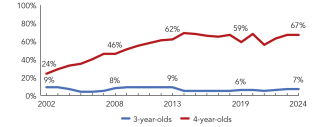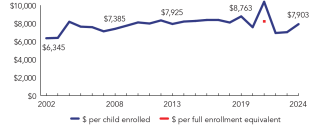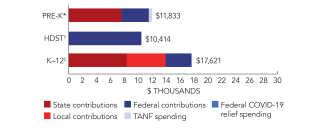
State of Preschool
West Virginia
Access Rankings
Resource Rankings
Total Benchmarks Met
Overview

During the 2023-2024 school year, West Virginia preschool enrolled 13,864 children, an increase of 133 from the prior year. State spending totaled $104,609,046 and an additional $4,464,621 in TANF funds and $497,104 in federal recovery funds supported the program, up $13,205,354 (14%), adjusted for inflation, since last year. State spending per child (including TANF and federal recovery funds) equaled $7,903 in 2023-2024, up $885 from 2022-2023, adjusted for inflation. West Virginia met 9 of 10 quality standards benchmarks.
What's New

Starting during the 2023-24 school year, all new assistant teachers must complete courses addressing the Science of Reading and Early Childhood Mathematics as part of the Early Childhood Classroom Assistant Teacher Authorization (ECCAT) pathway.
During the 2024-25 school year, counties are required to complete reviews of prospective instructional materials for the next curriculum 5-year cycle (July 1, 2025-June 30, 2030). Previously, county pre-K teams were required to choose from a state approved list. For the next cycle, they must use state-established criteria and pre-K summary scoresheet for their own review and complete their own review and adopt instructional material for the next school year. Counties may use results from a state cursory review of registered vendors to assist in selection. There were also minor changes to the WV Pre-K Standards: (1) updates to the Guiding Principles for the WV Pre-K Standards; (2) updates in math to include math habits of minds in developmentally appropriate terms and alignment with kindergarten to support a continuum of learning from pre-K; and (3) clarification of language in English language arts and science.
Background
West Virginia introduced public preschool in 1983 for 3- and 4-year-olds through the Public School Early Childhood Education program. In 2002, legislation passed that required pre-K to be available to all 4-year-olds by 2012. Today, West Virginia’s Universal Pre-K System provides pre-K programs in all 55 counties in the state, serving 4-year-olds, as well as some 3-year-olds with special needs, and some kindergarten-eligible children if it is determined that kindergarten placement is not in the child’s best interest.
Public schools receive West Virginia Universal Pre-K funding directly, with half of all programs required to partner with child care centers, private pre-K, or Head Start agencies to meet demand. During the 2023-2024 school year, the collaboration rate was 83%. Programs are permitted to use additional funding from IDEA and federal Head Start.
As of July 2013, all new lead teachers in nonpublic settings are required to have at least a BA in ECE or a related field and, as of July 2014, all assistant teachers are required to apply for the Early Childhood Classroom Assistant Teacher Authorization, which requires a CDA or equivalent, as determined by the West Virginia Board of Education. West Virginia also increased instructional days per year and hours per week to at least 1,500 minutes (25 hours) of instruction per week and 48,000 minutes (800 hours) of instruction per year. Programs must operate no fewer than four days per week.
The West Virginia Universal Pre-K program had undergone a multi-year study to assess the effects of program participation. Programs develop monitoring systems to offer ongoing continuous quality improvement, using reliable monitoring tools selected by a local collaborative team. Children are assessed three times per year using the Early Learning Scale, and this information is used to track child and program outcomes over time, guide teacher professional development and coaching, adjust instructional practices, and support school readiness.
West Virginia Universal Pre-K
Access
Resources
| Total state pre-K spending | $109,570,771 |
| Local match required? | No |
| State Head Start spending | $0 |
| State spending per child enrolled | $7,903 |
| All reported spending per child enrolled* | $11,833 |

*Pre-K programs may receive additional funds from federal or local sources that are not included in this figure. †Head Start per-child spending includes funding only for 3- and 4-year-olds. ‡K–12 expenditures include capital spending as well as current operating expenditures.
West Virginia Quality Standards Checklist
| Policy | Requirement | Benchmark | Meets Benchmark? |
|---|---|---|---|
For more information about the benchmarks, see the Executive Summary and the Roadmap to State pages. | 9benchmarks met | ||
| Early Learning & Development Standards Benchmark | Comprehensive, aligned, supported, culturally sensitive | Comprehensive, aligned, supported, culturally sensitive | |
| Curriculum Supports Benchmark | Approval process & supports | Approval process & supports | |
| Teacher Degree Benchmark | BA | BA | |
| Teacher Specialized Training Benchmark | ECE, CD, ECE SpEd | Specializing in pre-K | |
| Assistant Teacher Degree Benchmark | CDA | CDA or equivalent | |
| Staff Professional Development Benchmark | 15 hours/year; PD plans; Coaching (classrooms collaborating with Head Start) | For teachers & assistants: At least 15 hours/year; individual PD plans; coaching | |
| Maximum Class Size Benchmark | 20 (3- & 4-year-olds) | 20 or lower | |
| Staff to Child Ratio Benchmark | 1:10 (3- & 4-year-olds) | 1:10 or better | |
| Screening & Referral Benchmark | Vision, hearing, health & more | Vision, hearing & health screenings; & referral | |
| Continuous Quality Improvement System Benchmark | Structured classroom observations; Data used for program improvement | Structured classroom observations; data used for program improvement | |
